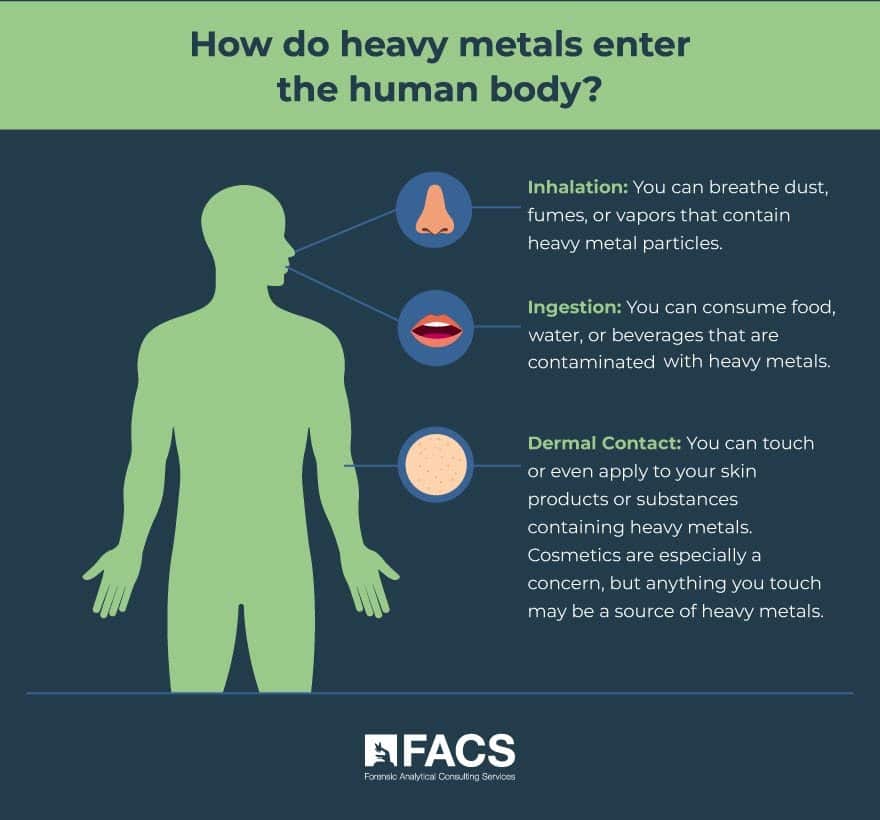Lead is an excellent additive for extending the durability of paint, but lead is toxic to humans. That’s why the residential use of lead-based paint was banned in the United States decades ago.
But lead is just one of a group of elements known as “heavy metals.” Your body needs some of those metals (iron, for instance) but only in trace amounts. Other metals are toxic to humans altogether. For example, there is no “safe” level of lead for human consumption. Any at all is too much. property.
That’s why the EPA and others who monitor public safety are concerned about heavy metal poisoning and work diligently to help prevent it from occurring. A primary barrier to that effort is getting the public to care about heavy metal poisoning. There are bigger stories in the news every day, but at FACS we don’t think many are more important to the long-term health of our children and other family members than this one.
What is heavy metal poisoning?
Heavy metal poisoning describes the toxic accumulation of certain heavy metals in the body. Symptoms of heavy metal poisoning vary according to the type of metal, amount of metal present, and duration of exposure. Complaints often reported are headaches, vomiting, and mental confusion. Metals such as lead, mercury, cadmium, and arsenic can have severe health effects even at relatively low concentrations.
How do people come into contact with heavy metals?
Don’t think that your workplace or home are clear of heavy metals. Batteries, cookware, plastic products, jewelry, and more are all potential sources of heavy metals. Lead-based paint regulations have lulled us into complacency. Plumbing fixtures, pressure-treated lumber, cement, and other materials used in building construction can still contain heavy metals.
How do heavy metals enter the human body?

What is “heavy metal bioaccumulation?”
Bioaccumulation is the usual means for heavy metal poisoning to occur. Once heavy metals enter your body, they can be stored in your brain, your liver, your blood — every major organ and system in your body is susceptible to heavy metal deposits. But your body has limited mechanisms to eliminate certain toxic heavy metals efficiently. That build-up can result in serious negative consequences for your health. Children are especially predisposed
Why Are Heavy Metals Harmful to Humans?
Heavy metals can interfere with various biochemical processes in the body. They might disrupt enzyme functions, alter cellular structures, and interfere with the normal functioning of organs.
The specific effects depend on the type of heavy metal and the level of exposure. For example:
- Lead: Known to affect the nervous system and cognitive development, particularly in children. It can also impact the cardiovascular and renal systems.
- Mercury: Can harm the nervous system, leading to symptoms like tremors, memory issues, and mood changes. Mercury exposure during pregnancy can affect fetal development.
- Cadmium: Primarily affects the kidneys, potentially leading to kidney disease. It can also have bone-related effects and increase the risk of certain cancers.
- Arsenic: Associated with skin lesions, cardiovascular issues, and an increased risk of lung cancers.
How Can Heavy Metal Poisoning Be Prevented?
Preventing heavy metal poisoning involves several measures:
- Regulation and Monitoring: Governments establish regulations to limit the presence of heavy metals in products, food, water, and the environment. Regular monitoring helps ensure compliance and timely intervention.
- Safe Practices: Industries should adopt proper waste management and disposal practices to minimize the release of heavy metals into the environment.
- Engineering Controls: It is often possible to remove hazards at their source or isolate workers from hazards. By implementing engineering controls, employers aim to minimize workplace risk before resorting to relying on worker behavior or personal protective equipment (PPE).
- Health Consciousness: Adequate nutrition supports the body’s detoxification processes. Other practices, like frequent handwashing and not wearing outside shoes inside the home can help prevent heavy metal poisoning.
Our aim is not to be alarmists who see a heavy metal poisoning problem in every corner, but the truth is that heavy metals are abundant in the built environment. They are present in our factories, our offices, and our homes. They are used on our streets and even in goods meant for personal use.
As was our stance during the recent epidemic: We’re not advising you to hide under your bed in fear, but to be better aware of heavy metals and the threat they bring to both human and environmental health.
FACS industrial health experts can sample your workplace for threats from heavy metals. Take this issue seriously. Call us: 888-711-9998.